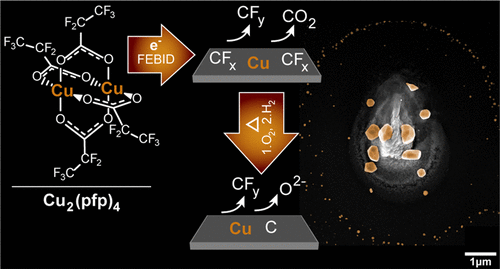当前位置:
X-MOL 学术
›
ACS Appl. Electron. Mater.
›
论文详情
Our official English website, www.x-mol.net, welcomes your
feedback! (Note: you will need to create a separate account there.)
High-Purity Copper Structures from a Perfluorinated Copper Carboxylate Using Focused Electron Beam Induced Deposition and Post-Purification
ACS Applied Electronic Materials ( IF 4.3 ) Pub Date : 2020-06-12 , DOI: 10.1021/acsaelm.0c00282 Luisa Berger 1 , Jakub Jurczyk 1, 2 , Katarzyna Madajska 3 , Thomas Edward James Edwards 1 , Iwona Szymańska 3 , Patrik Hoffmann 4 , Ivo Utke 1
ACS Applied Electronic Materials ( IF 4.3 ) Pub Date : 2020-06-12 , DOI: 10.1021/acsaelm.0c00282 Luisa Berger 1 , Jakub Jurczyk 1, 2 , Katarzyna Madajska 3 , Thomas Edward James Edwards 1 , Iwona Szymańska 3 , Patrik Hoffmann 4 , Ivo Utke 1
Affiliation

|
The electron-induced modification of volatile physisorbed metal–organic molecules is the key process in focused electron beam induced deposition (FEBID). In this work, the perfluorinated copper carboxylate [Cu2(μ-O2CC2F5)4], (Cu2(pfp)4), was implemented in FEBID, as it has the highest metal-to-carbon ratio Cu/C = 1:6 compared to other Cu precursors used so far. FEBID was obtained within a small temperature window of 120–130 °C. Transmission electron microscopy verified the presence of metal(oxide) nanocrystals within a carbonaceous matrix. The chemical composition analysis revealed the loss of about 80% of ligand material during the electron-induced dissociation. The copper nanocrystals oxidized within a few minutes in films <80 nm upon exposure to ambient conditions, while they were protected by a carbon–fluorine-containing matrix in thicker areas of the deposits. A two-step post-growth annealing procedure with subsequent oxidizing and reducing atmosphere was used to purify the deposits. Pure copper crystals were formed in this step.
中文翻译:

聚焦电子束诱导沉积和后净化技术从全氟化羧酸铜制得的高纯铜结构
挥发性物理吸附的金属有机分子的电子诱导修饰是聚焦电子束诱导沉积(FEBID)的关键过程。在这项工作中,全氟化羧酸铜[铜2(μ-O 2 CC 2 ˚F 5)4 ],(CU 2(PFP)4)是在FEBID中实施的,因为与迄今为止使用的其他Cu前体相比,它具有最高的金属碳比Cu / C = 1:6。FEBID是在120-130°C的较小温度范围内获得的。透射电子显微镜验证了碳质基质中金属(氧化物)纳米晶体的存在。化学成分分析表明,在电子诱导的离解过程中,配体材料损失了约80%。暴露于环境条件下,<80 nm的薄膜中的铜纳米晶体在几分钟之内被氧化,同时在较厚的沉积层中受到含碳氟基质的保护。使用两步的生长后退火程序以及随后的氧化和还原气氛来纯化沉积物。在此步骤中形成了纯铜晶体。
更新日期:2020-07-28
中文翻译:

聚焦电子束诱导沉积和后净化技术从全氟化羧酸铜制得的高纯铜结构
挥发性物理吸附的金属有机分子的电子诱导修饰是聚焦电子束诱导沉积(FEBID)的关键过程。在这项工作中,全氟化羧酸铜[铜2(μ-O 2 CC 2 ˚F 5)4 ],(CU 2(PFP)4)是在FEBID中实施的,因为与迄今为止使用的其他Cu前体相比,它具有最高的金属碳比Cu / C = 1:6。FEBID是在120-130°C的较小温度范围内获得的。透射电子显微镜验证了碳质基质中金属(氧化物)纳米晶体的存在。化学成分分析表明,在电子诱导的离解过程中,配体材料损失了约80%。暴露于环境条件下,<80 nm的薄膜中的铜纳米晶体在几分钟之内被氧化,同时在较厚的沉积层中受到含碳氟基质的保护。使用两步的生长后退火程序以及随后的氧化和还原气氛来纯化沉积物。在此步骤中形成了纯铜晶体。











































 京公网安备 11010802027423号
京公网安备 11010802027423号